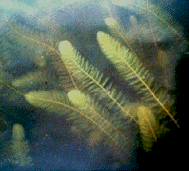Home → Water Quality → Monitoring → Invasives → Materials
Materials and Maine Laws involving Invasive Aquatic Plants

Definitions and Laws
Definition of Exotic Nuisance Alien Invasive Species and Native Indigenous Species
Discussions of Invasives Aquatic Plants include many words we all recognize, but the context is unfamiliar and confusing when applied to plants. In addition to the common usage, biologists use these terms to describe the ecological status of plant or animal populations and how they fit into a particular geographical region. Some terms are used interchangeably, such as nuisance and invasive, both with a negative connotation. Four categories (Binggeli, 1994) serve to cover the concepts used to describe the status and the distribution of a particular species.
- Native, Indigenous: species naturally occurring or originating in a geographical region since prehistorical time;
- Introduced, Alien, Exotic: deliberate or accidental release of a species into an area in which it has not occurred in historical times;
- Invasive: the establishment of self-regenerating and spreading populations of a naturalized species in a free-living state in the wild, takes possession and may affect injuriously;
- Nuisance, Noxious, Weed: any plant, either native or introduced, with a harmful or destructive influence on existing natural communities, interfering with the objectives or requirements of people.
These categories apply to biological communities, which are always evolving or changing due to fluctuating environmental conditions. Some species may be considered invasive if they occur in Maine but have been transported between watersheds and their introduction has caused detrimental effects to existing populations (e.g. introduction of white perch to brook trout waters has severely curtailed the beneficial values of brook trout in the affected waters). Some species in Maine fit into one or several of these categories, for example:
- Variable-leaf milfoil, a plant native to North America but not originally found in the Northeast U.S., is invasive and a nuisance when spread to new waterbodies
- Bladderwort, a common native aquatic plant that is occasionally considered invasive
- Purple Loosestrife is a rapidly spreading exotic invasive in wetland habitat
- Brook Trout, a desirable native that is not a nuisance
- Brown Trout, an introduced species that is not invasive or considered a nuisance
- Gold Fish or Carp are exotics that are also considered noxious invasives
The "Invasive Aquatic Plants" provisions are codified in a number of places in Maine Revised Statutes Annotated
5 MRSA 12004-D(6) -- Interagency task force expenses
12 MRSA 13001 -- (6) "aquatic plant" and (14) "invasive aquatic plant"
12 MRSA 13058 -- Lake and river protection sticker required
12 MRSA 13068(1) -- Launching contaminated watercraft
12 MRSA 13068(15) -- Violation of a surface use restriction order
12 MRSA 10257-- Lake and river protection fund
38 MRSA 410-N -- Aquatic nuisance species control
38 MRSA 419-C -- Prevention of the spread of invasive aquatic plants
38 MRSA Chapter 20-A -- Program to prevent infestation of and to control invasive aquatic plants
38 MRSA 20-B -- Invasive aquatic plants and nuisance species control
38 MRSA 1864 -- Emergency authority to regulate surface use
Other Resources
- Courtesy boat inspections webpage
- Invasive Aquatic Plants -- Known Locations in Maine (PDF) This map shows infestation areas by grouping contiguous lakes, rivers and streams into “lake systems.” Each system lists specific infested waters to provide as much precision as possible.
Printables and Presentations
- "Be Aware of Aquatic Invaders". A pamphlet addressing both milfoil and illegal fish stockings, courtesy of the Sportsmans' Alliance of Maine and the Maine Department of Inland Fisheries and Wildlife.
- Boat Ramp Warning Signs are deployed throughout the state to inform boaters and others of the infestation status of a given lake and to remind them of the importance of inspecting boats and boating gear before entering and exiting all surface waters. They are available for uninfested and for infested water bodies. To request a sign for a launch site, please use this form.
- Invasive Plant Fact Sheets (off-site) are available for free downloading from the Maine Natural Areas Program website, Maine Department of Agriculture, Conservation and Forestry.